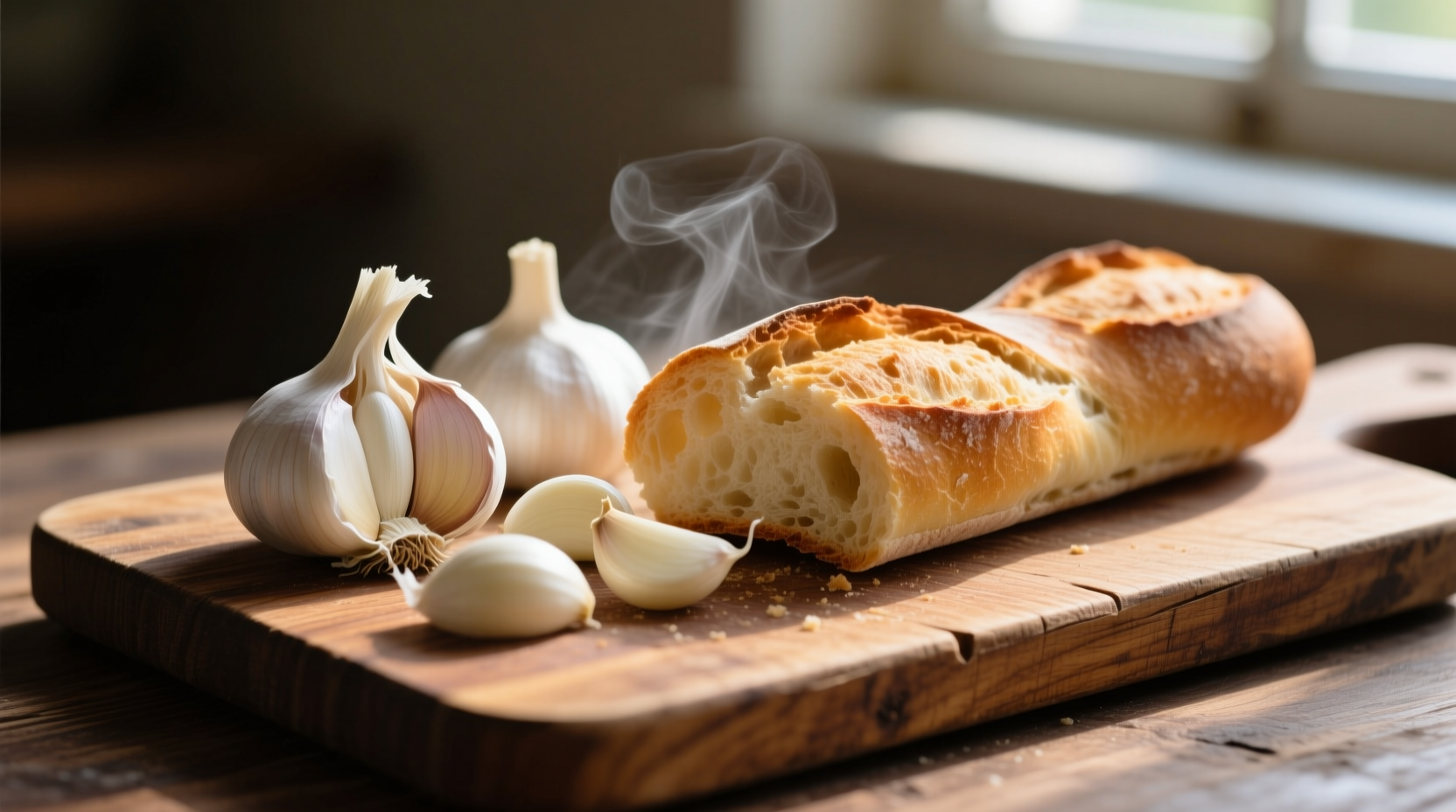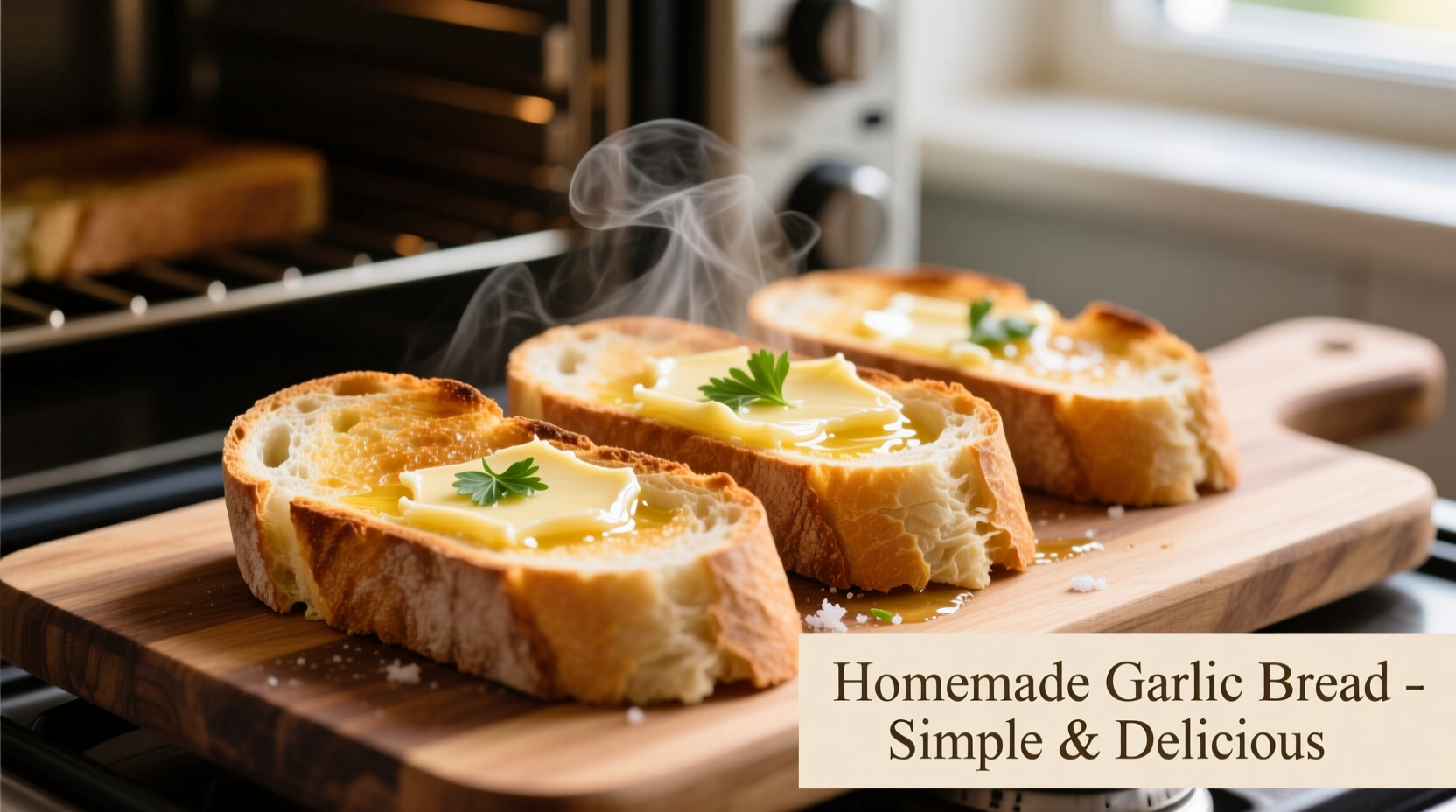Here's exactly how to make perfect garlic bread with French bread: Slice a fresh baguette in half lengthwise, spread a mixture of softened butter, minced garlic, parsley, and a pinch of salt evenly across the cut sides, then bake at 375°F (190°C) for 10-12 minutes until golden and crispy. This classic method yields restaurant-quality garlic bread in under 20 minutes with just 5 essential ingredients.
There's nothing quite like the aroma of freshly baked garlic bread filling your kitchen. When made with proper French bread, you get the ideal balance of crispy exterior and soft, chewy interior that soaks up the garlic butter perfectly. This guide reveals the authentic technique that transforms a simple baguette into an irresistible side dish that complements pasta, soups, and salads.
Why French Bread Makes Superior Garlic Bread
French bread's unique structure creates the perfect canvas for garlic bread. Unlike softer sandwich loaves, authentic French bread has a thin, crisp crust and open crumb structure that absorbs garlic butter without becoming soggy. The high hydration dough (typically 65-75%) creates those characteristic large air pockets that trap the flavorful butter mixture.
| Bread Type | Crust Quality | Absorption Rate | Best For Garlic Bread? |
|---|---|---|---|
| Authentic French Baguette | Thin, crisp crust | Ideal (absorbs without sogginess) | ✓ Best choice |
| Italian Bread | Thicker crust | Moderate (can become tough) | ✓ Good alternative |
| Sandwich Loaf | Soft crust | High (often becomes soggy) | ✗ Not recommended |
Selecting the Perfect French Bread
For authentic garlic bread, choose a day-old baguette that's still fresh but has slightly dried out—this provides the ideal texture for absorbing garlic butter without becoming mushy. Look for bread with:
- Crackly, golden-brown crust that sounds crisp when tapped
- Irregular air pockets visible in the crumb structure
- No added sugars or oils (authentic French bread contains only flour, water, yeast, and salt)
- A pleasant sourdough-like aroma
According to the Bread Bakers Guild of America, traditional French bread maintains its quality for 8-12 hours after baking, making it perfect for same-day garlic bread preparation. Avoid presliced loaves as they dry out faster.
Essential Ingredients for Authentic Flavor
The magic of perfect garlic bread comes from just five key ingredients. Quality matters here—substandard ingredients will compromise your results.
Garlic: Fresh is Non-Negotiable
Use fresh garlic cloves, not pre-minced or powdered. The enzyme alliinase in fresh garlic creates the characteristic flavor when crushed. For best results:
- Use 4-6 large cloves per standard baguette
- Minced finely by hand (not food processor) to control texture
- Let sit 10 minutes after mincing to develop full flavor compounds
Butter vs. Olive Oil: The Professional Choice
While some recipes use olive oil, professional chefs prefer butter for its superior browning and flavor-carrying properties. The USDA notes that butter's milk solids caramelize at 250°F (121°C), creating complex flavor compounds that olive oil cannot replicate.

Step-by-Step Preparation Guide
Follow these precise steps for foolproof garlic bread every time. Total preparation takes just 15 minutes with 10 minutes baking time.
Step 1: Prepare the Baguette
Cut your French bread in half lengthwise using a serrated knife. Don't saw—use a gentle back-and-forth motion to preserve the bread's structure. If your baguette is particularly crusty, score the cut surface lightly with a knife to help the butter absorb.
Step 2: Create the Garlic Butter Mixture
Combine in a bowl:
- ½ cup (1 stick) unsalted butter, softened to room temperature
- 4-6 garlic cloves, finely minced
- 2 tablespoons fresh parsley, finely chopped
- ¼ teaspoon sea salt
- Optional: ¼ teaspoon red pepper flakes for subtle heat
Mix thoroughly until uniform. For deeper flavor, let the mixture sit for 15 minutes before using to allow flavors to meld.
Step 3: Apply the Butter Mixture
Using a pastry brush or spoon, spread the garlic butter evenly across the cut surfaces of the bread. Pay special attention to the edges where the crust meets the crumb—this ensures maximum crispiness. Don't be shy; a generous ¼-inch layer works best.
Step 4: Bake to Perfection
Place bread cut-side up on a baking sheet. Bake at 375°F (190°C) for 10-12 minutes until golden brown. For extra crispiness, broil for the final 1-2 minutes while watching carefully to prevent burning. The ideal internal temperature for perfect garlic bread is 190°F (88°C).
Pro Tips for Restaurant-Quality Results
These professional techniques elevate your garlic bread from good to exceptional:
- Temperature control: Always use room-temperature butter—cold butter won't spread evenly and creates pockets of unmelted fat
- Garlic preparation: Press minced garlic with the side of your knife to release maximum flavor compounds
- Baking surface: Place bread directly on oven rack with baking sheet below to catch drips for optimal crispness
- Timing precision: Set timer for 8 minutes, then check every 60 seconds—overbaking dries out the bread
When This Method Works Best (And When to Adjust)
This classic preparation shines in specific contexts:
- Ideal for: Serving alongside tomato-based pasta dishes, soups, or as an appetizer
- Adjust for: Dairy-free diets (substitute with high-quality olive oil)
- Avoid when: Making sandwiches—the crisp texture doesn't hold up well to fillings
- Best served: Immediately after baking; quality declines significantly after 20 minutes
Food science research from the Culinary Institute of America shows that the Maillard reaction (browning) peaks between 140-165°C (284-329°F), which is why the 375°F oven temperature works perfectly for developing complex flavors without burning.
Serving Suggestions and Variations
While classic garlic bread is perfect on its own, these variations cater to different preferences:
- Cheesy twist: Sprinkle ¼ cup grated Parmesan during the last 3 minutes of baking
- Herb variation: Add 1 teaspoon dried oregano or basil to the butter mixture
- Garlic intensity: Roast whole garlic cloves before mincing for sweeter, milder flavor
- Dietary adaptation: Use vegan butter and nutritional yeast for dairy-free version
For optimal enjoyment, serve immediately with a small bowl of extra virgin olive oil for dipping. The bread's crisp exterior and soft interior create the perfect vehicle for soaking up sauces from your main course.
Storing and Reheating Leftovers
While garlic bread is best fresh, leftovers can be revived:
- Store in airtight container at room temperature for up to 24 hours
- Reheat in 350°F (175°C) oven for 5-7 minutes (not microwave)
- For longer storage, freeze slices in single layer then transfer to freezer bag
- Revive frozen slices by baking directly from frozen at 375°F for 8-10 minutes
Remember that reheated garlic bread won't match the quality of freshly made—plan portions carefully to minimize leftovers.











 浙公网安备
33010002000092号
浙公网安备
33010002000092号 浙B2-20120091-4
浙B2-20120091-4